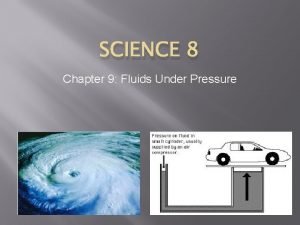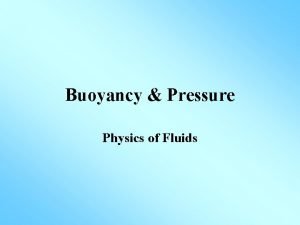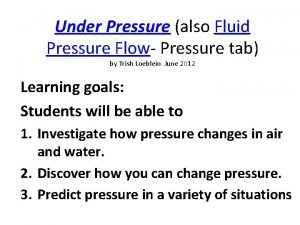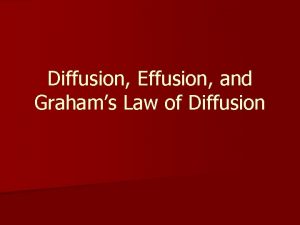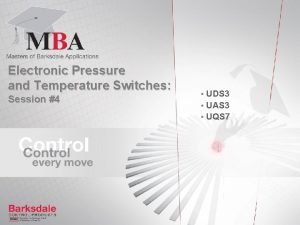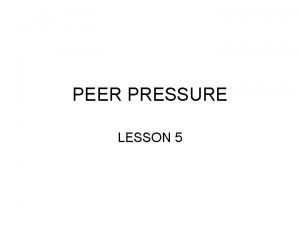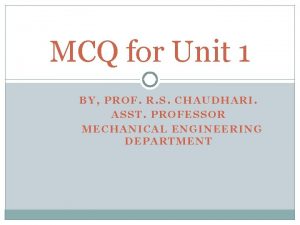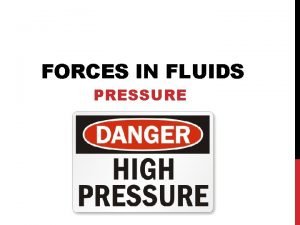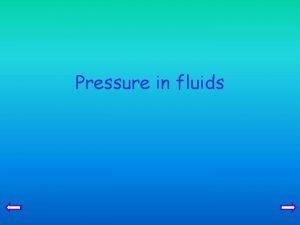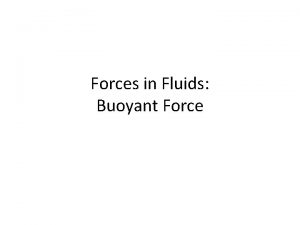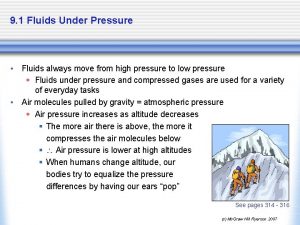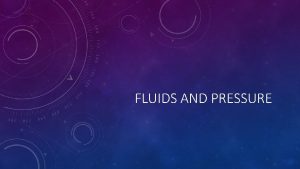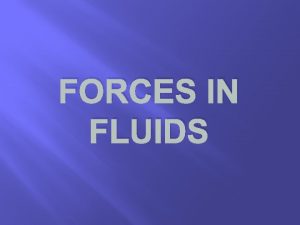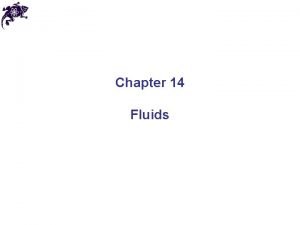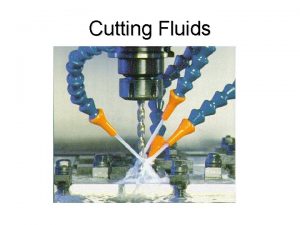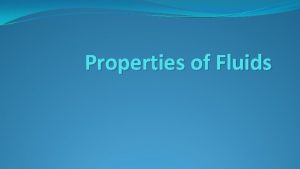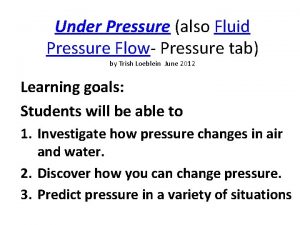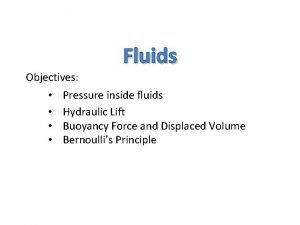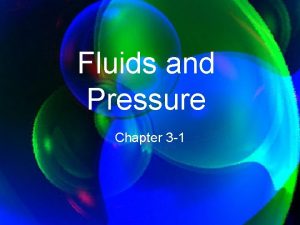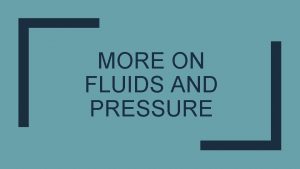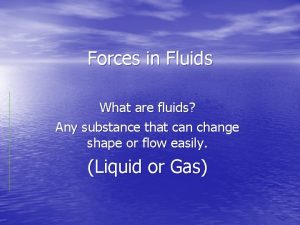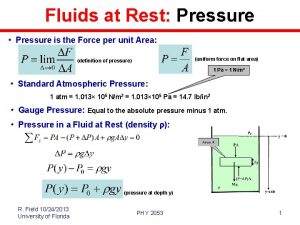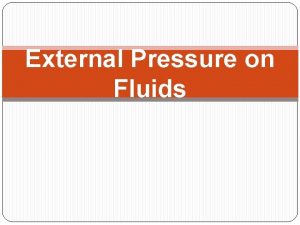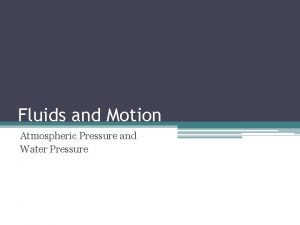Fluids under pressure Forces Anything that causes a





























- Slides: 29


Fluids under pressure

Forces • Anything that causes a change in the motion of an object. • A push or pull.

Balanced forces: • Are equal in strength • Are opposite in direction • No movement

Unbalanced forces: • Are unequal in strength • Cause a change in speed or direction

Mass vs. Weight MASS WEIGHT • Stays the same anywhere in the universe • Kilograms (kg) • A measure of the pull of gravity acting on an object. • Newton (N)


PRESSURE • The force acting on a certain area of surface. • The larger the force, the greater the pressure. • The smaller the area, the greater the pressure.

Think about it What puts more pressure on your paper, writing with a dull pencil or a sharp pencil? Why?

Compression • Is a decrease in volume caused by a force.

PHASES OF MATTER • SOLID • LIQUID • Holds shapes • Shape of container • Fixed Volume • GAS • Shape of Container • Volume of Container

Compressing • Which takes the most effort to compress? • Which takes the least effort to compress? • Why do you not want to heat compressed gasses? • What is deformation in solids?

Compressed vs Uncompressed

Why do you not want to heat compressed gasses? • Gas molecules hit the walls of the container • Each hit is a small force • When you heat compressed gasses, there are more hits more forces more pressure inside the container than outside • EXPLOSION!!!

Implosion vs Explosion

• IMPLOSION occurs when the pressure is lower inside than outside • EXPLOSION occurs when the pressure is lower outside than inside

Think of the pop can experiment • When you boil water the vapour pressure of the water is equal to the pressure due to the weight of the atmosphere • When you put the can in the cold water, the water vapour condenses, and the pressure decreases • WHY?

Why do you not want to heat compressed gasses? • When you cool gasses, there are fewer hits less forces less pressure inside the container than outside • IMPLOSION!!!

CALCULATING PRESSURE • The unit for pressure is the Pascal (Pa) • You can determine pressure if you know the force and the area

Pressure • Formula: Pressure (P) = Force (F) Area (A) P A

SAMPLE PROBLEM 1 • An aquarium is filled with water that weighs 10 000 N. If the base of the aquarium has an area of 1. 6 m², what pressure does the water exert on its base?

SAMPLE PROBLEM 1 • An aquarium is filled with water that weighs 10 000 N. If the base of the aquarium has an area of 1. 6 m², what pressure does the water exert on its base? Force = 10 000 N Area = 1. 6 m 2

Problem 1 Solution P A

Problem 1 Solution P = F A P= 10 000 N 1. 6 m² P = 6250 Pa P A

SAMPLE PROBLEM 2 • If the atmospheric pressure is 101 200 Pa and you are holding your hand, the atmosphere is exerting a force on your hand. If the area of your palm is 0. 006 m², calculate the force on your hand.

Problem 2 Solution F=Px. A F = 101 200 Pa 0. 006 m² F = 607 N P A

SAMPLE PROBLEM 3 • The weight of water in a glass is 4. 9 N. If the water is exerting a pressure of 1700 Pa on the bottom of the glass, what is the area of the bottom of the glass?

Problem 3 Solution A=F÷P A = 4. 9 N 1700 Pa A = 0. 003 m² P A

Assignment • Complete the practice problems
 Fluids under pressure
Fluids under pressure Liquid pressure unit
Liquid pressure unit Phân độ lown
Phân độ lown Block nhĩ thất độ 3
Block nhĩ thất độ 3 Thơ thất ngôn tứ tuyệt đường luật
Thơ thất ngôn tứ tuyệt đường luật Thơ thất ngôn tứ tuyệt đường luật
Thơ thất ngôn tứ tuyệt đường luật Walmart thất bại ở nhật
Walmart thất bại ở nhật Tìm độ lớn thật của tam giác abc
Tìm độ lớn thật của tam giác abc Con hãy đưa tay khi thấy người vấp ngã
Con hãy đưa tay khi thấy người vấp ngã Tôn thất thuyết là ai
Tôn thất thuyết là ai Gây tê cơ vuông thắt lưng
Gây tê cơ vuông thắt lưng Sau thất bại ở hồ điển triệt
Sau thất bại ở hồ điển triệt Causes of death under 18
Causes of death under 18 Proximate causes of behavior
Proximate causes of behavior Animal behavior biology
Animal behavior biology Fluid pressure
Fluid pressure Difference between diffusion and effusion
Difference between diffusion and effusion The role of management accounting in scorekeeping involves
The role of management accounting in scorekeeping involves Faith under pressure
Faith under pressure U u u u under pressure
U u u u under pressure 10 causes of peer pressure
10 causes of peer pressure Nph symptoms
Nph symptoms Causes of peer pressure
Causes of peer pressure Flat pivot bearing rate of wearing
Flat pivot bearing rate of wearing Define like and unlike parallel forces
Define like and unlike parallel forces The forces shown above are pushing/pulling forces
The forces shown above are pushing/pulling forces Intermolecular vs intramolecular forces
Intermolecular vs intramolecular forces Interu
Interu Inter vs intramolecular forces
Inter vs intramolecular forces Contact and noncontact forces
Contact and noncontact forces
